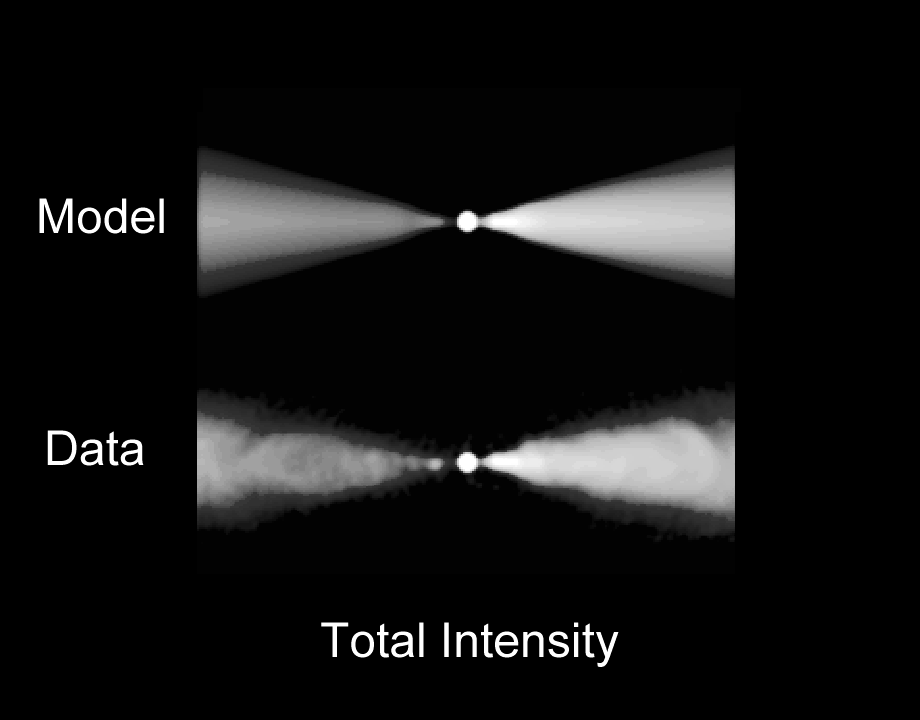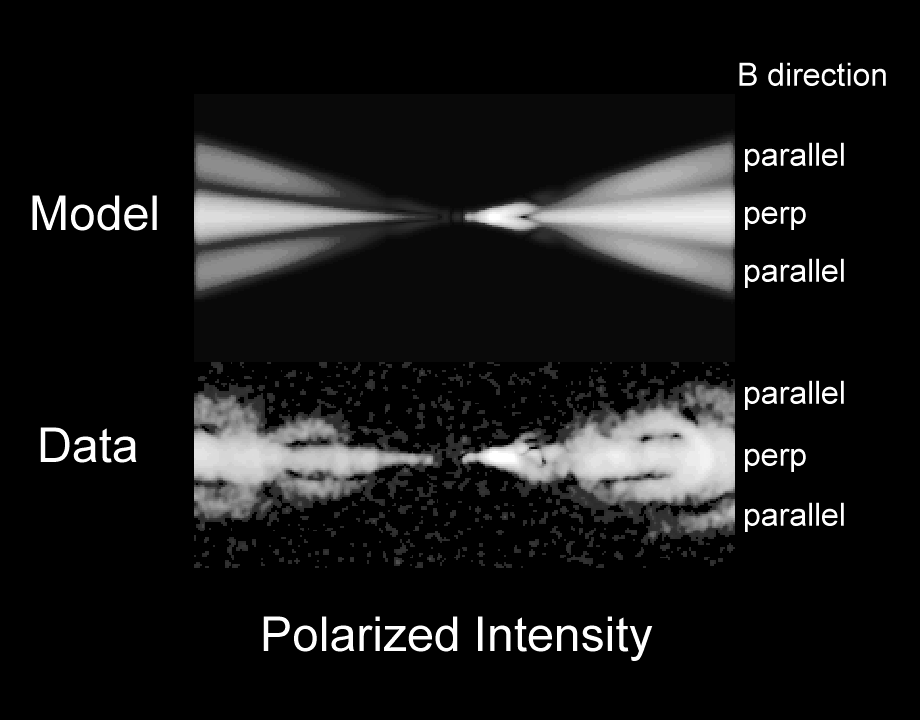

Many aspects of AGN radio jets can now be understood in the context of bulk-relativistic outflows launched from relativistically-deep potential wells in galactic nuclei. The most likely launching mechanism is "B++" -- a black hole plus a rotating accretion disk plus a magnetic field that is wound up by the rotation of the disk. In all models of jet launching from AGN by this mechanism, the jets emerge perpendicular to the axis of the disk. Direct evidence for the black holes, and for larger-scale disks around them, in active galactic nuclei is now coming from VLBI (e.g., Miyoshi et al. 1995; Herrnstein 1998), the HST (e.g., Harms et al. 1994; Ferrarese et al. 1996; Bower et al. 1998), and X-ray spectroscopy (e.g., Tanaka et al. 1995).
The VLA lets us examine how these outflows evolve as they propagate in the environments of their host galaxies and surrounding groups or clusters. It now seems likely that most jets, whether in FRI or FRII sources, retain a fast relativistic component out to the kiloparsec scale where the VLA begins to resolve them transversely. A key difference between the two Fanaroff-Riley classes (Fanaroff & Riley 1974) may be that the fast central "spine" decelerates to subrelativistic speeds within the galaxy in FRI sources, but persists as far as the distant hot spots in FRII sources.
Doppler favoritism of the approaching relativistic jet can explain why the observed brightness asymmetries (or sidedness) of the kiloparsec-scale (VLA) and parsec-scale (VLB) jets are so well correlated with each other, and with the depolarization asymmetry, in both Fanaroff-Riley structure types -- these attributes all diagnose which of the two jets is approaching us.
Doppler boosting and dimming in relativistic jets at different angles to our line of sight can also explain why the jets in FRII radio galaxies are harder to detect than those in lobe-dominated quasars. If the broad-line region of radio galaxies is obscured by material in a torus in roughly the same plane as the accretion disk, and if the jets indeed emerge perpendicular to this plane, then FRII radio galaxy jets will generally be closer to the plane of the sky than those in lobe-dominated quasars. (The latter are tilted towards us, allowing a view of the inner, broad-line, region.) The approaching jet in an FRII quasar can therefore be Doppler boosted, making it more prominent relative to the lobes (as well as strongly "one-sided"), while both jets in an FRII radio galaxy are Doppler dimmed, making them hard to detect until they terminate at the hot spots.
In the context of relativistic-jet models, the symmetrization of the jets in FRI sources with increasing distance from the galactic nucleus suggests that they decelerate as they propagate through the galactic environment on kiloparsec scales. The idea that some relativistic flow extends to ~1-kpc scales even in FRI sources is bolstered by the large proper motions found in M87 on these scales (Biretta et al. 1995). Bicknell (1995) showed how the bulk deceleration of FRI flows by mass entrainment from galactic atmospheres might explain why the FRI to FRII transition depends on both the luminosity of the radio source and on the optical luminosity of the galaxy (acting as a proxy for the central gas pressure).
If these ideas are correct, then high-resolution imaging of the bases of jets in FRI sources like NGC315 and 3C31 offers a way to probe how the galactic environment decelerates outflows whose initial momentum fluxes are lower than in FRII sources. Robert Laing and I are exploring how well models of decelerating relativistic jets can match the detailed intensity and polarization distributions of several FRI sources that are well resolved by the VLA. We assume that the fast-moving jet spine develops a slower-moving boundary layer, across which there is transport of gas from the galactic atmosphere, causing the spine to decelerate. The flow is initially fast, resembling that in an FRII source. But for a source at an intermediate angle to the line of sight, first the slower moving flow in the boundary layer, and then the flow in the jet spine, pass through the velocity at which their emission is optimally Doppler boosted. As pointed out by Komissaroff (1988, 1990) this can explain why both jets appear to brighten after an initially dim region (as they emerge from Doppler "hiding"). It can also explain:


| Figure 6: Direct comparisons of a decelerating relativistic-jet model (see text for details) and the VLA total (upper panel) and polarized (lower panel) intensity data for the inner parts of the jets in 3C31 at 8460 MHz (Laing, R.A., & Bridle, A.H., in preparation). |
Figure 6 compares a model of the emission from a decelerating relativistic jet with VLA data for 3C31 at the same resolution. In this model, the fast-moving spine, which occupies about 40% of the jet by radius, has a single velocity across the jet but decelerates with increasing distance from the nucleus. In the outer layer the flow velocity decreases linearly from the spine velocity closest to the axis to a low value at the edge of the jet. The jet and counterjet are intrinsically identical. The velocity field, the variation of the emissivity with distance from the nucleus, and the jet geometry have all been adjusted to fit the data. The (fitted) angle of the jet to the line of sight is 52°; the spine velocity decreases from 0.88c closest to the nucleus to 0.17c furthest from the nucleus, while the velocity at the edge of the jet decreases from 0.7c to 0.11c.
We have also specified the jet's internal magnetic field configuration. We assume that the spine contains random loops of magnetic field with no component along the direction of motion, while the boundary layer contains random loops with no component across the velocity shear. By accounting for the relativistic aberration of these partially-ordered magnetic fields we can also account for both jets' polarization properties, as shown in the lower half of Figure 6.
Although some details of the polarization "weather" (particularly a loop-like structure in the brighter jet) are unexplained, the model describes the total intensity and polarization "climate" in 3C31 well. Its ability to fit the major features of the observed total and polarized intensities for both jets with the same velocity distribution and magnetic field parameters suggests that the basic precepts of the decelerating-jet picture are correct.
Well-resolved VLA data on FRI sources like NGC315 and 3C31 may therefore allow us to infer information about the jet velocity fields, and thus about the kinematics of jet-gas interactions, in elliptical galaxies. This will be an important step towards understanding the galactic-scale processes that determine the differences between FRI and FRII sources.
Alan Bridle
Tue Oct 13 15:58:42 EDT 1998